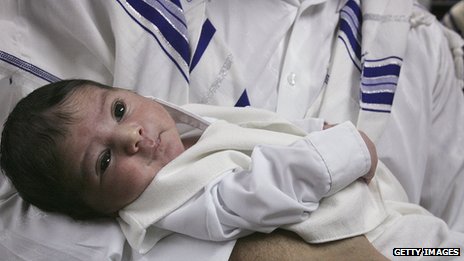 Is the circumcision of boys comparable to female genital mutilations?
Is the circumcision of boys comparable to female genital mutilations?
The “Children’s right to physical integrity” Resolution adopted by the Parliamentary Assembly of the Council of Europe (PACE) (1) on October 1st asserts that female genital mutilations and the circumcision of young boys for religious reasons are both “particularly worrisome practices”.
It is understandable that this wording, rightly perceived as a lumping together of the two practices, would have shocked, as it did, Jewish and Muslim communities in France as in the rest of Europe. Neither the distinction made between these two practices in the second part of the resolution (2) nor the explanations of the author of the resolution were sufficient to defuse the tension.
Circumcision is an essential ritual in Judaism. All male infants are circumcised eight days after they are born. It is also an obligation – or at least a strong recommendation – in Muslim religion that all boys be circumcised before puberty. In addition, circumcision is a commonly performed procedure in the United States, mainly for hygienic purposes. Globally, approximately 30 % of men older than 15 (about 661 million) have been circumcised according to a 2007 report of the World Health Organization (3).
A first controversy in Germany in 2012
The virulent reactions to the PACE resolution were predictable, given that the issue of circumcision had already created a controversy in 2012: the Cologne regional appellate court in Germany had set a precedent by ruling that religious circumcision of male children amounts to bodily injury and is a criminal offense. The impact of this ruling was felt in several European countries.
Germany’s Central Council of Jews had strongly condemned the ruling which, it said, amounted to “an unprecedented and dramatic intervention in religious communities’ right of determination”. Israel and Turkey had also voiced their discontent. Angela Merkel and the whole political class had then quickly reacted and the Bundestag eventually passed, by a large majority, a law explicitly authorizing religious circumcisions in the first six months of infancy, under proper medical conditions and with the least painful methods.
Germany had thus put an end to the controversy.
So why does the issue resurface?
The author of the PACE Resolution mentions “the opinion of specialists who provide evidence of circumcision’s potential risks for children’s health”.
However, other studies indicate that complication rates are low and easily managed most of the time (4). As to the American Academy of Pediatrics (AAP), its 2012 policy statement indicates that the health benefits of newborn male circumcision – especially protection against certain sexually transmitted diseases – outweigh the risks (though the benefits are not great enough to actually recommend universal newborn circumcision) (5).
The World Health Organization is more categorical, recommending circumcision in countries where the HIV virus is endemic (6).
Now it may be that all these studies are biased because they are “financed by American religious and medical lobbies”, as the French sex therapist Yves Ferroul (7) has claimed, but the accusation seems excessive.
The most sensible position
In the final analysis the most sensible position would be one taking into account the symbolic and religious dimensions – essential to many Jews, Muslims, but also Christians – as well as the two central issues concerning the child: his age and the treatment of pain.
According to psychiatrist Janet Menage circumcision creates a long-lasting trauma for the boy (8). And it is plausible that the older the child, the more serious both the pain and the resulting trauma.
Yet it is precisely these two concerns that are addressed by the German law of 2012 (and, incidentally, by the AAP policy statement as well).
Granted, the question of the physical integrity of the “non consenting” child strictly speaking remains unanswered. Meanwhile, better to focus the efforts first and foremost on practices other than circumcision, the harmful character of which is not even questionable!
(1) Advisory body made up of 642 members who are representatives of each of the 47 member states – including Turkey – and whose decisions constitute non-binding recommendations, mainly in the areas of human rights, democracy, protection of minorities and the rule of law.
(2) Indeed, the text recommends: banning female genital mutilations; defining clearly the medical conditions to be ensured as regards the religious practices; providing specific training to the religious representatives on a voluntary basis.
(3) “Male circumcision – Global trends and determinants of safety, prevalence and acceptability” (a 2007 World Health Organization report) http://whqlibdoc.who.int/publications/2007/9789241596169_eng.pdf p.8
(4) http://www.ncbi.nlm.nih.gov/pmc/articles/PMC3253617/
(5) http://www.aap.org/en-us/about-the-aap/aap-press-room/Pages/Newborn-Male-Circumcision.aspx and http://www.npr.org/blogs/health/2012/08/27/159 955340/pediatricians-decide-boys-are-better-off-circumcised-than-not
(6) “Male circumcision – Global trends and determinants of safety, prevalence and acceptability” (a 2007 World Health Organization report) http://whqlibdoc.who.int/publications/2007/9789241596169_eng.pdf
(7) (in French) http://leplus.nouvelobs.com/contribution/961125-le-conseil-de-l-europe-condamne-la-circoncision-rituelle-le-droit-des-enfants-avant-tout.html
(8) http://www.norm-uk.org/circumcision_psychological_effects.html and Necla Kelek, in “Die verlorenen Söhne. Plädoyer für die Befreiung des türkisch-muslimischen Mannes” (The lost sons. Plea for the liberation of the Turkish Muslim man) Kiepenheuer & Witsch, Cologne, 2006





